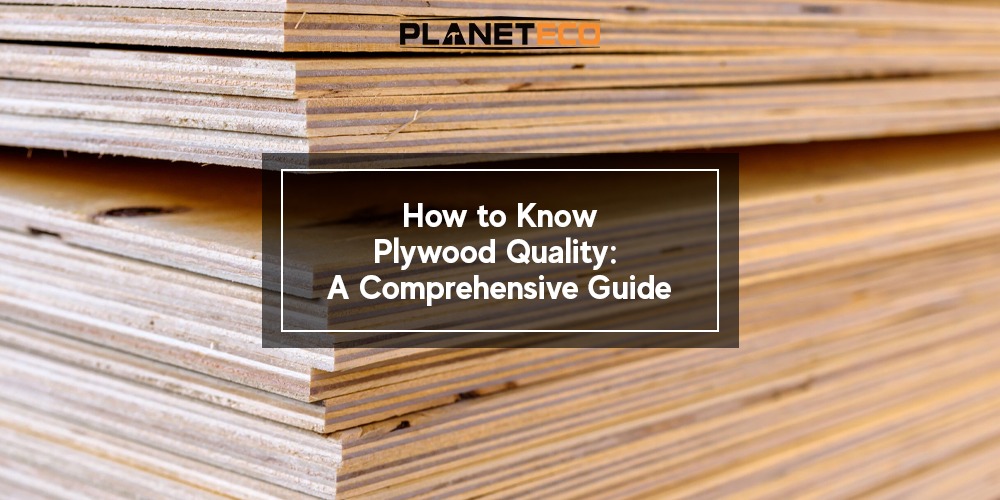Choosing the right plywood is crucial for any construction or furniture project. Plywood’s quality significantly impacts your finished product’s durability, strength, and overall look. But how can you tell if the plywood you’re buying is high quality? In this guide, we’ll explore the key factors to consider when evaluating plywood quality and introduce you to a trusted supplier, Planeteco, for all your plywood needs.
Understanding Plywood Grades
Plywood is classified into different grades based on quality, with each grade suitable for specific applications.
The primary grades are:
- A-Grade Plywood: This is the highest-quality plywood, with a smooth surface free from knots and defects. It is ideal for furniture and cabinet making, where appearance is important.
- B-Grade Plywood: Slightly lower in quality than A-grade, B-grade plywood may have some minor imperfections. It suits interior applications where aesthetics are still important but less critical.
- C-Grade Plywood: This grade contains noticeable defects such as knots and splits. It is often used for structural applications where the plywood is not visible.
- D-Grade Plywood: The lowest quality, with significant defects, D-grade plywood is typically used for construction where it will be covered.
Core Veneer Quality
The core veneer is the inner layer of plywood, and its quality is vital for the plywood’s strength and stability. Here’s what to look for:
- Uniform Thickness: High-quality plywood will have evenly thick core veneers, ensuring stability and strength.
- No Gaps or Voids: Inspect the edges of the plywood sheet for gaps or voids in the core. High-quality plywood should be free from these imperfections.
- Type of Wood: The wood used for the core veneers also affects quality. Hardwood cores generally offer better strength and durability compared to softwood cores.
Surface Veneer Quality
The outer layers of plywood, known as face veneers, should be smooth and free from defects for high-quality plywood. Here are some points to consider:
- Smoothness: A smooth surface veneer indicates better quality. It should be free from patches, splits, and rough spots.
- Consistency: The grain pattern should be consistent across the surface, indicating high-quality craftsmanship.
- Finish: High-quality plywood will have a fine finish, making it easier to work with for painting or staining.
Glue Bond
The adhesive used to bond the veneers is critical in determining plywood quality. Plywood is classified into two types based on the glue bond:
- Exterior Plywood (BWP – Boiling WaterProof): This type of plywood uses phenol formaldehyde resin, which is waterproof and suitable for exterior applications.
- Interior Plywood (MR—Moisture Resistant): This type of plywood is made of urea formaldehyde resin, which makes it suitable for indoor use where moisture exposure is minimal.
Certification and Standards
Certified plywood ensures that the product meets industry standards for quality and safety. Look for plywood that adheres to these certifications:
- IS: 303 and IS: 710: These are Indian Standards for moisture-resistant and waterproof plywood, respectively.
- E1 or E0 Certification: This indicates low formaldehyde emissions, making the plywood safer for indoor use.
Environmental Considerations
Sustainable sourcing and eco-friendliness are becoming increasingly important in the construction industry. Opt for plywood that is:
- FSC Certified: The Forest Stewardship Council (FSC) certification ensures that the wood used comes from responsibly managed forests.
- Low VOC: Plywood with low volatile organic compound (VOC) emissions is better for indoor air quality.
Practical Tips for Evaluating Plywood Quality
Here are some practical steps you can take when assessing plywood quality:
- Visual Inspection: Check for a smooth, consistent surface free from defects.
- Edge Check: Inspect the edges for uniform thickness and the absence of gaps or voids.
- Bend Test: Slightly bend the plywood to check for flexibility. Good quality plywood will have a degree of flexibility but should not crack or delaminate.
- Knock Test: Tap on the plywood surface; a consistent sound indicates uniform density.
Choosing a Reliable Plywood Supplier
Selecting a reputable plywood supplier is crucial for ensuring you receive high-quality products. One such trusted supplier is Planeteco. Planeteco offers a wide range of plywood options that meet stringent quality standards, ensuring durability and performance for your projects. With a commitment to sustainability and customer satisfaction, Planeteco stands out as a top choice for plywood supplies.
Why Choose Planeteco?
- High-Quality Products: Planeteco ensures that all their plywood products meet high standards for quality and performance.
- Sustainability: They prioritize eco-friendly products and sustainable sourcing, making them a responsible choice for environmentally conscious consumers.
- Wide Range of Options: Whether you need plywood for furniture, cabinetry, or construction, Planeteco offers a variety of grades and types to suit your needs.
- Expert Advice: Planeteco’s knowledgeable team can help you choose the right plywood for your project requirements.
Conclusion
Knowing how to evaluate plywood quality is essential for ensuring the success and longevity of your construction or furniture projects. By considering factors such as grade, core and surface veneer quality, glue bond, certifications, and environmental impact, you can make an informed decision. For reliable, high-quality plywood, consider partnering with a reputable supplier like Planeteco. Their commitment to quality and sustainability ensures that you’ll receive the best materials for your needs.
For more information on choosing the right plywood and to explore a wide range of options, visit Planeteco. Your next project deserves the best, and with Planeteco, you can be confident in the quality and sustainability of your materials.

